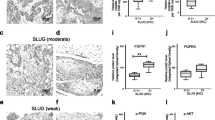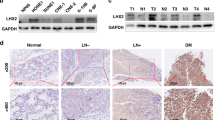Abstract
Epidermal growth factor receptor (EGFR) and its downstream elements are overexpressed in most cases of the head and neck squamous cell carcinoma. This study investigated the expression pattern of key proteins linked to the EGFR pathway in laryngeal carcinoma patients with a history of cannabis smoking. We selected 83 male glottic cancer patients, aged between 45 to 75 years with three distinct populations—nonsmoker, cigarette smoker, and cannabis smoker. Immunohistochemical staining was performed for EGFR, protein kinase B (PKB or Akt), nuclear factor kappa B p50 (NF-КB), and cyclooxygenase-2 (COX-2) followed by boolean scoring for statistical analysis. Experimental data showed upregulation of the selected EGFR cascade in tumor cells, stromal expression of EGFR, and nuclear localization of COX-2 in metaplastic gland cells of laryngeal cancer tissue sample. Statistical analyses indicated that overexpression of the EGFR cascade is significantly correlated to cannabis smoking. Cannabis smokers had higher expression (p < 0.01) of these onco-proteins with respect to both nonsmokers as well as cigarette smokers. Risk factor analysis showed high risk of these proteins expression in age <60 years (odds ratio (OR) > 1.5) as the lower age group had relatively higher number of cannabis smokers. This study provides evidence for a direct association between cannabis smoking and increased risk of laryngeal cancer. Higher expression of the EGFR cascade in cannabis smokers revealed that cannabis smoking may be a major cause for the early onset of aggressive laryngeal cancer.





Similar content being viewed by others
References
Iversen L. The science of cannabis. Oxford: Oxford University Press; 2000.
Martin B, Cone E. Chemistry and pharmacology of cannabis. In: Kalant H, Corrigal W, Hall WD, Smart RG, editors. The health effects of cannabis. Toronto: Centre for Addiction and Mental Health; 1999.
Global illicit drug trends. New York: United Nations Office on Drugs and Crime; 2003. p. 136–140.
Hall W, Christie M, Currow D. Cannabinoids and cancer: causation, remediation, and palliation. Lancet Oncol. 2005;6:35–42.
Hall WD, MacPhee D. Cannabis use and cancer. Addiction. 2002;97:243–7.
Zhang LR, Morgenstern H, Greenland S, et al. Cannabis smoking and lung cancer risk: pooled analysis in the International Lung Cancer Consortium. Int J Cancer. 2014. doi:10.1002/ijc.29036.
Gomez Del Pulgar T, Velasco G, Guzman M. The CB1 cannabinoid receptor is coupled to the activation of protein kinase B/Akt. Biochem J. 2000;347:369–73.
West KA, Brognard J, Clark AS, Linnoila IR, Yang X, Swain SM, et al. Rapid Akt activation by nicotine and a tobacco carcinogen modulates the phenotype of normal human airway epithelial cells. J Clin Invest. 2003;111:81–90.
Panikashvili D, Simeonidou C, Ben-Shabat S, Hanus L, Breuer A, Mechoulam R, et al. An endogenous cannabinoid (2-AG) is neuroprotective after brain injury. Nature. 2001;413:527–31.
Leker RR, Shohami E, Abramsky O, Ovadia H. Dexanabinol; a novel neuroprotective drug in experimental focal cerebral ischemia. J Neurol Sci. 1999;162(2):114–9.
Roth MD, Marques-Magallanes JA, Yuan M, Sun W, Tashkin DP, Hankinson O. Induction and regulation of the carcinogen-metabolizing enzyme CYP1A1 by cannabis smoke and Delta (9)-tetrahydrocannabinol. Am J Respir Cell Mol Biol. 2001;24:339–44.
Brennan JA, Boyle JO, et al. Association between cigarette smoking and mutation of the p53 gene in squamous cell carcinoma of the head and neck. N Engl J Med. 1995;332(11):712–7.
Citri A, Yarden Y. EGF-ERBB signalling: towards the systems level. Nat Rev Mol Cell Biol. 2006;7(7):505–16.
Kalyankrishna S, Grandis JR. Epidermal growth factor receptor biology in head and neck cancer. J Clin Oncol. 2006;24(17):2666–72.
Ciardiello F, Tortora G. EGFR antagonists in cancer treatment. N Engl J Med. 2008;358(11):1160–74.
Grandis JR, Tweardy DJ. TGF-alpha and EGFR in head and neck cancer. J Cell Biochem Suppl. 1993;17F:188–91.
Takes RP, Baatenburg de Jong RJ, Schuuring E, et al. Differences in expression of oncogenes and tumor suppressor genes in different sites of head and neck squamous cell. Anticancer Res. 1998;18(6B):4793–800.
Ang KK, Berkey BA, Tu X, et al. Impact of epidermal growth factor receptor expression on survival and pattern of relapse in patients with advanced head and neck carcinoma. Cancer Res. 2002;62(24):7350–6.
Kim S, Grandis JR, Rinaldo A, et al. Emerging perspectives in epidermal growth factor receptor targeting in head and neck cancer. Head Neck. 2008;30(5):667–74.
Ford AC, Grandis JR. Targeting epidermal growth factor receptor in head and neck cancer. Head Neck. 2003;25(1):67–73.
Lothaire P, de Azambiya E, Dequanter D, et al. Molecular markers of head and neck squamous cell carcinoma: promising signs in need of prospective evaluation. Head Neck. 2006;28(3):256–69.
Reuter CW, Morgan MA, Eckardt A. Targeting EGF-receptor-signalling in squamous cell carcinomas of the head and neck. Br J Cancer. 2007;96(3):408–16.
Scaltriti M, Baselga J. The epidermal growth factor rececptor pathway: a model for targeted therapy. Clin Cancer Res. 2006;12(18):5268–72.
Loercher A, Lee TL, Ricker JL, et al. Nuclear factor-kappaB is an important modulator of the altered gene expression profile and malignant phenotype in squamous cell carcinoma. Cancer Res. 2004;64(18):6511–23.
Chen Z, Malhotra PS, Thomas GR, et al. Expression of proinflammatory and proangiogenic cytokines in patients with head and neck cancer. Clin Cancer Res. 1999;5(6):1369–79.
Ondrey FG, Dong G, Sunwoo J, et al. Constitutive activation of transcription factors NF-(kappa)B, AP-1, and NF-IL6 in human head and neck squamous cell carcinoma cell lines that express pro-inflammatory and pro-angiogenic cytokines. Mol Carcinog. 1999;26(2):119–29.
Zhang PL, Pellitteri PK, Law A, et al. Overexpression of phosphorylated nuclear factor-kappa B in tonsillar squamous cell carcinoma and high-grade dysplasia is associated with poor prognosis. Mod Pathol. 2005;18(7):924–32.
Anto RJ, Mukhopadhyay A, Shishodia S, et al. Cigarette smoke condensate activates nuclear transcription factor-kappaB through phosphorylation and degradation of IkappaB(alpha): correlation with induction of cyclooxygenase-2. Carcinogenesis. 2002;23(9):1511–8.
Lin SC, Lu SY, Lee SY, et al. Areca (betel) nut extract activates mitogen-activated protein kinases and NF-kappaB in oral keratinocytes. Int J Cancer. 2005;116(4):526–35.
Karmali RA, Wustrow T, Thaler HT, Strong EW. Prostaglandins in carcinomas of the head and neck. Cancer Lett. 1984;22:333–6.
Jung TTK, Berlinger NT, Juhn SK. Prostaglandins in squamous cell carcinoma of the head and neck: a preliminary study. Laryngoscope. 1985;95:307–12.
Sheng H, Shao J, Morrow JD, Beauchamp RD, DuBois RN. Modulation of apoptosis and Bcl-2 expression by prostaglandin E2 in human colon cancer cells. Cancer Res. 1998;58:362–6.
Tsujii M, Kawano S, Tsuji S, Sawaoka H, Hori M, DuBois RN. Cyclooxygenase regulates angiogenesis induced by colon cancer cells. Cell. 1998;93:705–16.
Huang M, Stolina M, et al. Non-small cell lung cancer cyclooxygenase-2-dependent regulation of cytokine balance in lymphocytes and macrophages: upregulation of interleukin 10 and down-regulation of interleukin 12 production. Cancer Res. 1998;58:1208–16.
Tsujii M, DuBois RN. Alterations in cellular adhesion and apoptosis in epithelial cells overexpressing prostaglandin endoperoxide synthase. Cell. 1995;83:493–501.
Tsujii M, Kawano S, DuBois RN. Cyclooxygenase-2 expression in human colon cancer cells increases metastatic potential. Proc Natl Acad Sci U S A. 1997;94:3336–40.
Janot F, Massaad L, Ribrag V, de Waziers I, Beaune PH, Luboinski B, et al. Principal xenobiotic-metabolizing enzyme systems in human head and neck squamous cell carcinoma. Carcinogenesis. 1993;14:1279–83.
Zhang ZF, Morgenstern H, Spitz RM, et al. Cannabis use and increased risk of squamous cell carcinoma of the head and neck. Cancer Epidemiol Biomarkers Prev. 1999;8:1071–8.
Hashibe M, Morgenstern H, Cui Y, et al. Cannabis use and the risk of lung and upper aerodigestive tract cancers: results of a population-based case-control study. Cancer Epidemiol Biomarkers Prev. 2006;15:1829–34.
Zhu LX, Sharma S, Stolina M, et al. Delta-9-tetrahydrocannabinol inhibits antitumor immunity by a CB2 receptor-mediated, cytokine-dependent pathway. J Immunol. 2000;165:373–80.
Sarafian TA, Tashkin DP, Roth MD. Cannabis smoke and delta(9)-tetrahydrocannabinol promote necrotic cell death but inhibit Fas-mediated apoptosis. Toxicol Appl Pharmacol. 2001;174:264–72.
Guzman M. Cannabinoids: potential anticancer agents. Nat Rev Cancer. 2003;3:745–55.
Blazquez C, Casanova ML, Planas A, et al. Inhibition of tumor angiogenesis by cannabinoids. FASEB J. 2003;17:529–31.
Barsky SH, Roth MD, Kleerup EC, Simmons M, Tashkin DP. Histopathologic and molecular alterations in bronchial epithelium in habitual smokers of cannabis, cocaine, and/or tobacco. J Natl Cancer Inst. 1998;90:1198–205.
Fligiel SE, Venkat H, Gong Jr H, Tashkin DP. Bronchial pathology in chronic cannabis smokers: a light and electron microscopic study. J Psychoactive Drugs. 1988;20:33–42.
Pupa SM, Menard S, Forti S, Tagliabue E. New insights into the role of extracellular matrix during tumor onset and progression. J Cell Physiol. 2002;192:259–67.
Yang C-M, Lee I-T, Lin C-C, Yang Y-L, Luo S-F, Kou YR, et al. Cigarette smoke extract induces COX-2 expression via a PKC a/c-Src/EGFR, PDGFR/PI3K/Akt/NF-kB pathway and p300 in tracheal smooth muscle cells. Am J Physiol Lung Cell Mol Physiol. 2009;297:L892–902.
Kourelis K, Vandoros G, et al. Low COX2 in tumor and upregulation in stroma mark laryngeal squamous cell carcinoma progression. Laryngoscope. 2009;119(9):1723–9.
Lappi-Blanco E, Kaarteenaho-Wiik R, et al. COX-2 is widely expressed in metaplastic epithelium in pulmonary fibrous disorders. Am J Clin Pathol. 2006;126:717–24.
Araya J, Cambier S, Markovics JA, et al. Squamous metaplasia amplifies pathologic epithelial-mesenchymal interactions in COPD patients. J Clin Invest. 2007;117(11):3551–62.
Reis-Filho JS, Milanezi F, et al. Metaplastic breast carcinomas are basal-like tumours. Histopathology. 2006;49:10–21.
Acknowledgments
We thank Prof. (Dr.) Jaydip Biswas, Director, CNCI, for his support throughout the entire project and the Department of Science and Technology (DST), India, for funding the project.
Conflict of interest
None
Author information
Authors and Affiliations
Corresponding author
Electronic supplementary material
Below is the link to the electronic supplementary material.
Online Resource 1
(PDF 297 kb)
Online Resource 2
(PDF 249 kb)
Online Resource 3
(PDF 188 kb)
Online Resource 4
(PDF 253 kb)
Rights and permissions
About this article
Cite this article
Bhattacharyya, S., Mandal, S., Banerjee, S. et al. Cannabis smoke can be a major risk factor for early-age laryngeal cancer—a molecular signaling-based approach. Tumor Biol. 36, 6029–6036 (2015). https://doi.org/10.1007/s13277-015-3279-4
Received:
Accepted:
Published:
Issue Date:
DOI: https://doi.org/10.1007/s13277-015-3279-4




